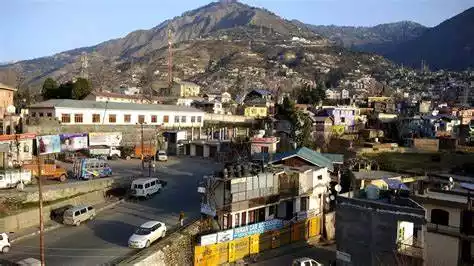Discovering Doda: A Comprehensive Guide to Jammu and Kashmir's Enigmatic District
Introduction to Doda
Doda, a district nestled in the union territory of Jammu and Kashmir, is a region of captivating natural beauty, rich cultural heritage, and historical significance. Located in the northeastern part of Jammu Division, Doda is bordered by several other districts, including Anantnag, Kishtwar, Ramban, and Udhampur. This article delves into the various aspects of Doda, from its geographical splendor and diverse demographics to its unique cuisine, cultural richness, and administrative structure.
Geography and Natural Landscape
Majestic Mountains and Scenic Valleys
Doda is renowned for its picturesque landscapes dominated by towering mountains and serene valleys. The district is part of the Lesser Himalayas, offering breathtaking views and a tranquil environment. The Chenab River flows through the district, enhancing its natural beauty and providing opportunities for various water-based activities.
Climate and Weather Patterns
The climate in Doda varies significantly with altitude. The lower regions experience a subtropical climate, while the higher altitudes have a temperate to alpine climate. Summers are generally mild, making it a perfect season for trekking and outdoor activities, whereas winters are cold with heavy snowfall in higher regions, attracting winter sports enthusiasts.
Demographics and Culture
Population and Ethnic Composition
Doda has a diverse population comprising various ethnic groups and communities. According to the latest census, the district has a population of approximately 409,576 people. The majority of the population is Muslim, followed by Hindus, with smaller communities of Sikhs and Buddhists. This ethnic diversity contributes to the district's rich cultural tapestry.
Languages Spoken
The linguistic landscape of Doda is equally diverse. The primary languages spoken include Kashmiri, Dogri, Bhaderwahi, and Gojri. Urdu and Hindi are also widely understood and used for official communication. This multilingual environment reflects the district's complex cultural heritage.
Festivals and Cultural Events
Doda's cultural calendar is marked by numerous festivals and events that showcase the district's vibrant traditions. Festivals like Eid-ul-Fitr, Eid-ul-Adha, Diwali, and Holi are celebrated with great enthusiasm. Additionally, local festivals such as Bhaderwah Mela and Kailash Yatra attract visitors and highlight the unique cultural practices of the region.
Historical Background
Ancient and Medieval History
Doda has a rich historical background that dates back to ancient times. The region was part of the larger kingdom of Kashmir and has witnessed the rule of various dynasties, including the Mauryas, Kushans, and Guptas. During the medieval period, it came under the influence of the Mughal Empire and later the Dogra rulers.
Modern Era and Independence
In the modern era, Doda became part of the princely state of Jammu and Kashmir under the Dogra dynasty. Post-independence, it was integrated into the Indian Union. The district has since evolved significantly, with development initiatives aimed at improving infrastructure and the quality of life for its residents.
Cuisines of Doda
Traditional Dishes and Culinary Practices
Doda's cuisine is a delightful blend of various culinary traditions. Some of the popular dishes include:
- Rogan Josh: A fragrant lamb curry cooked with a blend of spices.
- Dum Aloo: Potatoes cooked in a rich, spiced yogurt gravy.
- Yakhni: A yogurt-based mutton dish flavored with mild spices.
- Gushtaba: Meatballs made from minced mutton, cooked in a creamy yogurt sauce.
Local Ingredients and Cooking Methods
The cuisine of Doda prominently features locally sourced ingredients such as rice, wheat, and maize, along with fresh vegetables and dairy products. Traditional cooking methods involve slow-cooking over wood fire, which imparts a unique flavor to the dishes.
Administration and Governance
Administrative Structure
Doda district is administratively divided into several tehsils, including Doda, Bhaderwah, and Thathri. The district is governed by a Deputy Commissioner, who is responsible for overseeing the implementation of government policies and programs.
Local Governance and Development Initiatives
Local governance in Doda includes Panchayati Raj institutions that facilitate grassroots participation in decision-making processes. Various development initiatives focus on improving infrastructure, education, healthcare, and rural development to enhance the living standards of the residents.
Tourist Attractions
Bhaderwah: The Mini Kashmir
Bhaderwah, often referred to as "Mini Kashmir," is one of the most popular tourist destinations in Doda. Known for its lush green meadows, dense forests, and sparkling streams, Bhaderwah offers numerous trekking routes and sightseeing opportunities.
Kishtwar National Park
Located on the eastern side of Doda, Kishtwar National Park is a haven for wildlife enthusiasts. The park is home to a variety of flora and fauna, including the Himalayan black bear, snow leopard, and several species of birds.
Ancient Temples and Historical Sites
Doda is dotted with ancient temples and historical sites that reflect its rich cultural heritage. The Vasukinag Temple in Bhaderwah and the Nagni Mata Temple are notable examples of the district's architectural and religious significance.
Conclusion
Doda, with its stunning natural beauty, rich cultural heritage, and historical importance, is a district that captivates the hearts of those who visit. From its diverse population and vibrant festivals to its delectable cuisine and majestic landscapes, Doda offers a unique blend of experiences. As efforts continue to develop the region, Doda is poised to become an even more significant destination for tourists and a cherished home for its residents.
This comprehensive guide to Doda aims to provide an in-depth understanding of the district, highlighting its key features and attractions. Whether you are a potential visitor or someone interested in learning more about this enchanting region, Doda's allure is bound to leave a lasting impression.
